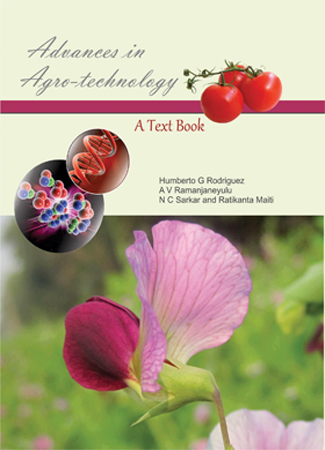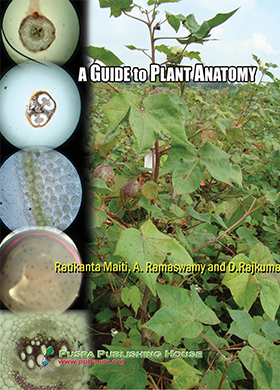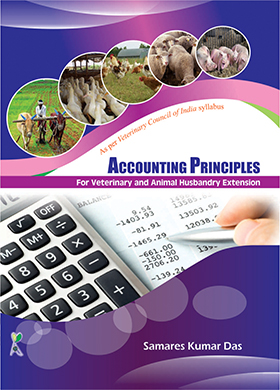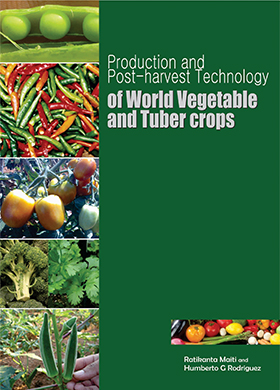Research Article
Profitability, Resource Use Efficiency and Marketing of Potato in East Siang Districts of Arunachal Pradesh, India
Lakshmi Dhar Hatai
- Page No: 702 - 708
- Published online: 31 Jul 2022
- DOI : HTTPS://DOI.ORG/10.23910/1.2022.3004
-
Abstract
-
lakshmidharhatai@gmail.com
The present study was undertaken with a sample size of 90 potato growers of East Siang district of Arunachal Pradesh State, India through stratified random sampling during 2019–20. The cost of cultivation was estimated based on cost concept. Cobb-Douglas production function was used as the better fit over linear form to find out the resource use efficiency of each variable input in potato production process. It was revealed that the total cost of cultivation on small, medium and large farms were Rs. 41604, Rs. 44150 and Rs. 44608 ha-1 respectively. Potato cultivation is highly labour intensive, as human labour contributes about 30% in Cost C3 (total cost). The gross return varied between Rs. 179914 ha-1 on large farms and Rs. 117927 ha-1 on small farms. The benefit-cost ratio varied between 3.16 to 5.63. There were many problems related to recurrent price fluctuation, high marketing, storage and transportation costs, inadequate storage facilities and lack of competitive marketing. For resource-use efficiency, the ratios of MVP to MFC were greater than one for human labour showing significant under-utilization of this resource and possibility of additional use to achieve the optimal level. Adoption of new production technology with sustained resources utilization can help farmers in minimizing the cost of production. In Arunachal Pradesh, the potato production and marketing can be improved by constructing the cold storage units in rural areas near production points, improving the market intelligence services and to make availability of the reliable information on processing and value addition, through small scale industries, FPOs and cooperatives.
Keywords : Arunachal Pradesh, marketing, potato, profitability, resource use efficiency
-
INTRODUCTION
Potato is designated as “Food for Future” by FAO because of its high productivity and nutritive value. Potato has been historically the most important vegetable and continues to receive the same status as on date. Potato (Solanum tuberosum) possesses all the virtues to be a potential food crop. It produces substantially more edible energy, protein and dry matter per unit area and time than many other crops. Potato is now the world’s third most important food crop in terms of human consumption, after wheat and rice. Potato tubers constitute a highly nutritious, wholesome food. Potato plays a very important role in Indian agriculture as it alone contributes about 21% of the area 26% of production under vegetable crops in India. Potatoes are a good source of energy, minerals, proteins, fats and vitamins (Ekin, 2011,Drewnowski and Rehm, 2013, King and Slavin, 2013). FAO declared potato as the crop to address future global food security and poverty alleviation during 2008. Potato is currently grown on an estimated 20 mha of farmland globally, and the potato production worldwide stands for 366 mt(Anonymous, 2020). India produced 48.6 mt of potato and ranked second in the world, only after China(99.2 mt). The productivity in India is higher than in China and Russia, the third largest potato producer (Anonymous, 2008).
Potato is a food security crop in the current global food system (Devauxetal., 2021, Haverkort and Struik,2015).Sustainable potato production and efficient use of resources will require adjustments and redesigns of the current cropping and processing systems (Andrivon, 2017). Potato is a profitable enterprise in spite of high capital requirement (Verma and Rajput, 2002). Cultivation of high yielding variety is more profitable for potato growers (Singh and Kishore, 1997). Unless prices are fixed above production costs, it may not be possible to meaningfully improve potato production (Naik and Patnaik, 1986).
Potato is a high yield potential and nutritionally superior crop(Kochetal., 2020). It could help in banishing hunger, malnutrition, more specifically in the developing and under developed countries. Its cultivation is one of the alternatives for the diversification of agriculture and development of agro-processing industries. Potato plays a significant role in the agriculture economy (Sinha and Singh, 2019). In Arunachal Pradesh, Potato is one of the important vegetable crops covering an area of 6200 ha. with a production of 44950 mt (2019‒20). In East Siang district, it occupies an area of 790 ha with 16.28 per cent of state production (2018‒19).
Sustainable agri-food system includes productivity, agricultural income, human wellbeing and environmental sustainability (Smith et al., 2017, Wu et al., 2018). Adoption of new production technology with sustained resources utilization can help farmers in minimizing the cost of production of potato. The value chain fragmentation, price volatility, quality and quantity losses and low levels of processing that characterize the market for horticultural crops in India (Gulati et. al., 2022). New paradigm and challenges are needed for potato growers of Arunachal Pradesh in solving the problems like recurrent price fluctuation, high marketing, storage and transportation cost, non-availability of adequate storage facilities, post-harvest losses and lack of competitive marketing system. In keeping with the preferences of consumers, a greater variety of appealing potato products have been developed, including potato steamed bread, potato noodles and flour (Su and Wang, 2019). Keeping the view of importance of State’s economy, this effort has been made for which the main objectives of the study are profitability, resource use efficiency and marketing of potato in East Siang Districts of Arunachal Pradesh.
-
MATERIALS AND METHODS
The present study was undertaken with a sample of 90 potato growers comprising 40 small (<2 ha), 30 medium (2−4 ha) and 20 large (>4 ha) farmers from twelve villages of three CD blocks namely, Paighat, Mebo, and Ruksin of East Siang district, Arunachal Pradesh, India through stratified random sampling method. Besides, 12 traders and 18 retailers in Pasighat market were also randomly chosen. Data pertaining to the agricultural year 2019−20 was considered with specific objectives. On the basis of the different cost concepts of CACP, Govt. of India (Cost A1, Cost A2, Cost B1, Cost B2, Cost C1, Cost C2,Cost C2 and Cost C3), the cost of cultivation has been estimated. The net returns over different cost concepts have been estimated as the difference between the gross return and particular cost. The benefit-cost ratios over different cost concepts were calculated by dividing the gross return by a particular cost., Simple percentage, average, percentage of multiple responses for constraints faced by potato growers and appropriate formulae as per methodology was used to analyze the collected primary data.
2.1. Cost concepts
To work out the costs and returns of potato production, cost concept recommended by the Commission for Agricultural Costs and Prices (CACP) was used viz., Cost A1, Cost A2, Cost B1, Cost B2, Cost C1, Cost C2 and Cost C3wasused.
Cost A1 :Value of hired human labour+Attached labour, Value of owned and hired bullock labour+charges on owned and hired machinery+Value of seed (both farm produced and purchased)+Value of owned and purchased manures+value of fertilizers+value of plant protection chemicals used+ depreciations+ repairs and maintenance of farm machinery and farm implements and farm buildings+land revenue, cesses+interest on working capital.
Cost A2 :Cost A1+Rent paid on leased in land.
Cost B1 : Cost A2+Imputed interest on owned fixed capital excluding land.
Cost B2 :Cost B1+Rental value of owned land (less land revenue) and Rent paid for leased in land.
Cost C1 :Cost B1+Imputed value of family labour
Cost C2 :Cost B2+Imputed value of family labour
Cost C3 :Cost C2+10 % of Cost C2 as management of cost
2.2. Cobb-Douglas production function
Based on the significance of the results, the Cobb-Douglas production function was used as the better fit over linear form to find out the resource use efficiency of each variable input in potato production process:
Y=aπxbieui………………(1)
Where, Y=Yield of potato in quintals ha-1
a=intercept
Π=multiplication symbol
X1=Hired human labour in man days ha-1
X2=Seed in ` ha-1
X3=Fertilizers in ` ha-1
X4=Plant protection measures in ` ha-1
X5=Irrigation in ` ha-1
u=Error term or disturbance term
bi=Regression coefficient of the ith variable
e=Napier base i.e. 2.718
On the basis of marginal value productivity (MVP), the resource use efficiency was judged. It is imperative to study efficient resource allocation in agricultural production from the viewpoint of the national use of scarce resources and maximization of farm income. The MVP of the ith input was worked out by using the following formula:
MVP=bi (Y-/X-i)Py…………….(2)
Where, Y=Geometric mean of yield of potato ha-1
Xi=Geometric mean level of ith resources
bi=Production elasticity of ith input
Py=Price of the product
2.3. Marketing costs
These include all the marketing charges from local assembling to retailing in the marketing process. Marketing costs limit the income of the farmers, affect the cost of living of consumers and define the margins and profits of the marketing agencies.
The total cost incurred on marketing either in cash or in kind by the producer, seller and by the various intermediaries involved in the sale and purchase of the commodity reaches the ultimate consumer.
C=CF++CM1+CM2+CM3+…..++CMn
Where, C = Total cost of marketing of commodity
CF=Cost paid by the producer
CMi=Cost incurred by the ith middleman in the process of buying and selling the product.
-
RESULTS AND DISCUSSION
3.1. Cost of cultivation of potato
The total cost of cultivation (C3) was highest on large farms (Table 1). It was due to use of more inputs and higher expenses on labour, seed material, fertilizer and plant protection measures by contract potato cultivations. The total cost of cultivation on small, medium and large farms were Rs. 41604, Rs. 44150 and Rs. 44608 ha-1 respectively. Potato cultivation is highly labour intensive, as human labour contributes about 30%. The gross return varied between Rs. 179914 ha-1 on large farms and Rs. 117927 ha-1 on small farms (Table 2). The productivity and average price received by large farmers were also the highest. The net return in potato cultivation over Cost C2 was Rs. 32432 and Rs. 28499 over Cost C3. The benefit cost ratio varied between 3.16−5.63, while it was 3.57−5.35 on overall farm category wise estimation.
3.2. Resource use efficiency
It was observed that on all categories of farm sizes the ratios of MVP to MFC were greater than one for human labour showing significant under-utilization of this resource and possibility of additional use to achieve the optimal level (Table 3). This indicates that by spending an extra rupee on human labour the farmer, on average, will be able to generate additional returns worth ` 2.46. In the case of medium farms, the MVP:MFC ratio for fertilizer use was less than unity implying its uneconomic use. The ratios were negative for seed and plant protection on large farms suggesting curtailing their excessive use. Over all, the uses of variable inputs were being expanded to generate higher level of returns.
3.2. Resource use efficiency
It was observed that on all categories of farm sizes the ratios of MVP to MFC were greater than one for human labour showing significant under-utilization of this resource and possibility of additional use to achieve the optimal level (Table 3). This indicates that by spending an extra rupee on human labour the farmer, on average, will be able to generate additional returns worth ` 2.46. In the case of medium farms, the MVP:MFC ratio for fertilizer use was less than unity implying its uneconomic use. The ratios were negative for seed and plant protection on large farms suggesting curtailing their excessive use. Over all, the uses of variable inputs were being expanded to generate higher level of returns.
3.3. Marketing of potato
About 35% of produce was directly sold to the retailer by potato growers. The small farmers sold about 6% of potato to the processor directly (Table 4). The processing units used to make papad, chips, flakes and potato floor etc. in small units for local consumption. The disposal of potato through wholesalers were accounted for about 75, 57, 45% of production on small, medium and large farms in the marketing channel of Producer-Processor-Wholesaler- Retailer – Consumer.
The price received by the farmer was the highest ` 2.54 kg-1 when potato was directly sold to consumer and the lowest ` 1.50 kg-1 for the sale through retailer. The marketing cost incurred by sample potato growers for the sale through wholesaler, processor, consumer and retailer were ` 0.88, ` 0.82, ` 0.40 and ` 0.08 kg-1 respectively. However, the net price received by the sample farmer was highest when directly sold to consumers (` 2.14 kg-1).
3.3. Marketing of potato
About 35% of produce was directly sold to the retailer by potato growers. The small farmers sold about 6% of potato to the processor directly (Table 4). The processing units used to make papad, chips, flakes and potato floor etc. in small units for local consumption. The disposal of potato through wholesalers were accounted for about 75, 57, 45% of production on small, medium and large farms in the marketing channel of Producer-Processor-Wholesaler- Retailer – Consumer.
The price received by the farmer was the highest ` 2.54 kg-1 when potato was directly sold to consumer and the lowest ` 1.50 kg-1 for the sale through retailer. The marketing cost incurred by sample potato growers for the sale through wholesaler, processor, consumer and retailer were ` 0.88, ` 0.82, ` 0.40 and ` 0.08 kg-1 respectively. However, the net price received by the sample farmer was highest when directly sold to consumers (` 2.14 kg-1).
3.4. Constraints in production and marketing
About 85% of the farmers were facing the problem of infestation of potato crop by Epilachna beetle and Late Blight diseases (Phytophthora infestance). About 60% of potato growers even complained about the high cost of inputs. Overall, about 42% of the farmers were concerned with the poor quality of pesticides and facing the scarcity of labour force during peak period of potato production (<10%). Lack of sufficient number of cold storage capacity in that area compelled the farmers to sell their produce soon after harvest. Low price in the wholesale market, seasonal fluctuation in prices due to irregular supply were unique feature of marketing problem faced by potato growers of the study area (Table 5). Usually, efficient marketing provides higher return to producer and greater satisfaction to the consumer by way of reduction in marketing cost. Farmers experience very difficulties to dispose their produce at remunerative price during the glut situation in the market. High transportation, grading, bagging and storage costs in the retailer market created major marketing problems. Hence, they could sell only small amount of production to retailers. It was observed that large potato growing farmers were more reluctant for direct sale to the consumer due to lack of labour and longer period of requirement for marketing of their produce as compared to medium and small farmers.
-
CONCLUSION
The productivity and average price received by large farmers were highest in all categories of farm sizes. The net price received by the sample farmer was highest when directly sold to consumers. Potato production and marketing can be improved by providing adequate short-term credit facilities through PACS, constructing the cold storage units in rural areas, formation of FPOs and by improving the market intelligence services. Potato growers should be educated and encouraged for contract farming in order to hedge risk.
Table 1: Farm category-wise cost of cultivation of potato in East Siang District of Arunachal Pradesh (` ha-1)
Table 2: Farm category-wise estimation of net return and benefit-cost ratio of potato
Table 3: The MVP and MFC of important inputs for potato cultivation of sample farms in East Siang District
Table 4: Disposal trend and prices of Potato in different categories of sample farms in East Siang District
Table 5: Production and marketing constraints faced by sample potato growers in East Siang District (% Multiple response)
Table 1: Farm category-wise cost of cultivation of potato in East Siang District of Arunachal Pradesh (` ha-1)
Table 2: Farm category-wise estimation of net return and benefit-cost ratio of potato
Table 3: The MVP and MFC of important inputs for potato cultivation of sample farms in East Siang District
Table 4: Disposal trend and prices of Potato in different categories of sample farms in East Siang District
Table 5: Production and marketing constraints faced by sample potato growers in East Siang District (% Multiple response)
Table 1: Farm category-wise cost of cultivation of potato in East Siang District of Arunachal Pradesh (` ha-1)
Table 2: Farm category-wise estimation of net return and benefit-cost ratio of potato
Table 3: The MVP and MFC of important inputs for potato cultivation of sample farms in East Siang District
Table 4: Disposal trend and prices of Potato in different categories of sample farms in East Siang District
Table 5: Production and marketing constraints faced by sample potato growers in East Siang District (% Multiple response)
Table 1: Farm category-wise cost of cultivation of potato in East Siang District of Arunachal Pradesh (` ha-1)
Table 2: Farm category-wise estimation of net return and benefit-cost ratio of potato
Table 3: The MVP and MFC of important inputs for potato cultivation of sample farms in East Siang District
Table 4: Disposal trend and prices of Potato in different categories of sample farms in East Siang District
Table 5: Production and marketing constraints faced by sample potato growers in East Siang District (% Multiple response)
Table 1: Farm category-wise cost of cultivation of potato in East Siang District of Arunachal Pradesh (` ha-1)
Table 2: Farm category-wise estimation of net return and benefit-cost ratio of potato
Table 3: The MVP and MFC of important inputs for potato cultivation of sample farms in East Siang District
Table 4: Disposal trend and prices of Potato in different categories of sample farms in East Siang District
Table 5: Production and marketing constraints faced by sample potato growers in East Siang District (% Multiple response)
Reference
-
Andrivon, D., 2017. Potato facing global challenges: How, how much, how well? European Potato Journal 60(3–4), 389–400. DOI https://doi.org/10.1007/s11540-018-9386-z.
Anonymous, 2018. Department of Agriculture, Government of Arunachal Pradesh. Available athttp://agri.arunachal.gov.in/crop.php#111. Accessed on 20th March 2022.
Anonymous, 2008. FAO. Available at http://www.fao.org/potato-2008/en/potato/factsheets.html. Accessed on 15th March, 2022.
Anonymous, 2020. FAOSTAT Database. Available at http://www.fao.org/faostat/en/#data/QC. Accessed on 5th June, 2022.
Devaux, A., Goffart, J.P., Kromann, P., 2021. The potato of the future: opportunities and challenges in sustainable agri-food systems. Potato Research 64, 681–720. DOI https://doi.org/10.1007/s11540-021-09501-4.
Drewnowski, A., Rehm, C.D., 2013. Vegetable cost metrics show that potatoes and beans provide most nutrients per penny. PLoS One 8(5), e63277. DOI https://doi.org/10.1371/journal.pone.0063277.
Ekin, Z., 2011. Some analytical quality characteristics for evaluating the utilization and consumption of potato (Solanum tuberosum L.) tubers. African Journal of Biotechnology 10, 6001–6010.
Gulati, A., Wardhan, H., Sharma, P., 2022. Tomato, onion and potato (TOP) value chains. In: Gulati, A., Ganguly, K., Wardhan, H. (Eds.). Agricultural Value Chains in India: Ensuring Competitiveness, Inclusiveness, Sustainability, Scalability, and Improved Finance (ISBE series). Springer, Singapore, 33–97. https://doi.org/10.1007/978-981-33-4268-2_3.
Haverkort, A.J., Struik, P.C., 2015. Yield levels of potato crops: Recent achievements and future prospects. Field Crops Research 182, 76–85.
King, J.C., Slavin, J.L., 2013. White potatoes, human health, and dietary guidance. Advances in Nutrition 4(3), 393S–401S. DOI https://doi.org/10.3945/an.112.003525.
Koch, M., Naumann, M., Pawelzik, E., Gransee, A.,Thiel, H., 2020. The importance of nutrient management for potato production part I: Plant nutrition and yield. Potato Research 63, 97–119. DOI https://doi.org/10.1007/s11540-019-09431-2.
Naik, D., Pattanaik, S.C., 1986. An evaluation of price policy of potato in Orissa. Agricultural Situation in India 41(8), 623–628.
Singh, T.R., Kishore, R., 1997. Production performance of potato in district Farrukhabad (Uttar Pradesh). Indian Journal of Agricultural Economics 52(3), 635.
Sinha, A.K., Singh, S.K., 2019. Economics of potato production in northern hills of Chhattisgarh. Economic Affairs 64(1), 1–7.
Smith, A., Snapp, S., Chikowoa, R., Thorne, P., Bekunda, B., Gloverd, J., 2017. Measuring sustainable intensification in smallholder agroecosystems: a review. Global Food Security 12, 127–138.
Su, W., Wang, J., 2019. Potato and food security in China. American Journal of Potato Research 96, 100–101.
Verma, A.R., Rajput, A.M., 2002. Economics of production and marketing of potato in Indore district of Madhya Pradesh. Indian Journal of Agricultural Marketing 14(2), 23–30.
Wu, W., Yu, Q., You, L., Chen, K., Tang, H., Liu, J., 2018. Global cropping intensity gaps: Increasing food production without cropland expansion. Land Use Policy 76(C), 515–525.
Cite
Hatai, L.D. 2022. Profitability, Resource Use Efficiency and Marketing of Potato in East Siang Districts of Arunachal Pradesh, India . International Journal of Bio-resource and Stress Management. 13,1(Jul. 2022), 702-708. DOI: https://doi.org/10.23910/1.2022.3004 .
Hatai, L.D. Profitability, Resource Use Efficiency and Marketing of Potato in East Siang Districts of Arunachal Pradesh, India . IJBSM 2022,13, 702-708.
and L. D. Hatai, " Profitability, Resource Use Efficiency and Marketing of Potato in East Siang Districts of Arunachal Pradesh, India ", IJBSM, vol. 13, no. 1, pp. 702-708,Jul. 2022.
Hatai LD. Profitability, Resource Use Efficiency and Marketing of Potato in East Siang Districts of Arunachal Pradesh, India IJBSM [Internet]. 31Jul.2022[cited 8Feb.2022];13(1):702-708. Available from: http://www.pphouse.org/ijbsm-article-details.php?article=1640
doi = {10.23910/1.2022.3004 },
url = { HTTPS://DOI.ORG/10.23910/1.2022.3004 },
year = 2022,
month = {Jul},
publisher = {Puspa Publishing House},
volume = {13},
number = {1},
pages = {702--708},
author = { Lakshmi Dhar Hatai and },
title = { Profitability, Resource Use Efficiency and Marketing of Potato in East Siang Districts of Arunachal Pradesh, India },
journal = {International Journal of Bio-resource and Stress Management}
}
DO - 10.23910/1.2022.3004
UR - HTTPS://DOI.ORG/10.23910/1.2022.3004
TI - Profitability, Resource Use Efficiency and Marketing of Potato in East Siang Districts of Arunachal Pradesh, India
T2 - International Journal of Bio-resource and Stress Management
AU - Hatai, Lakshmi Dhar
AU -
PY - 2022
DA - 2022/Jul/Sun
PB - Puspa Publishing House
SP - 702-708
IS - 1
VL - 13
People also read
Full Research
Lateral Bearing Trait in Indian Walnut (Juglans regia L.) Germplasm: a Potential Yield Contributing Trait in Early Age of the Tree
L. Chand, D. B. Singh, O. C. Sharma, J. I. Mir, K. L. Kumawat, K. M. Rai, S. A. Rather, I. Qureshi, S. Lal and Inder DevIndian walnut, bearing habit, leafy shoot, yield
Published Online : 07 Oct 2017
Research Article
Profitability, Resource Use Efficiency and Marketing of Potato in East Siang Districts of Arunachal Pradesh, India
Lakshmi Dhar HataiArunachal Pradesh, marketing, potato, profitability, resource use efficiency
Published Online : 31 Jul 2022
Research Article
Disturbance to Myristica swamps: Influence on Specific Gravity and Fibre Length of an Endemic and Endangered Tree Species of Western Ghats
B. Tambat, N. Rajaskekar Murthy, K. N. Muniswamy Gowda, G. N. Chaithra, Anil K. Sethy and M. Mahadev MurthyMyristicaceae, swampy, disturbance, specific gravity, fibre length, Western Ghats, wood
Published Online : 28 Feb 2019
Research Article
Assessment of Water Balance Components of Bhadar River Basin Using SWAT Model
Jainish Kelaiya and P. H. RankArc GIS, Bhadar, water balance, SWAT, groundwater
Published Online : 03 May 2019
Research Article
Genetic Diversity of Amaranthus dubius Mart. (Khedha) Used Tribal Place in Chhattisgarh, India
Deepika Chandravanshi, P. K. Sharma, C. Banjare and Deepa ChandravanshiIdentification, khedha, Raipur
Published Online : 31 Oct 2018
Full Research
Application of CSM-CERES-Maize Model to Define a Sowing Window and Nitrogen Rates for Rainfed Maize in Semi-arid Environment
P. Leela Rani*, G. Sreenivas and D. Raji ReddyDSSAT, CERES-Maize, crop management, sowing window, nitrogen level
Published Online : 07 Jun 2014



.jpg)
.jpg)






